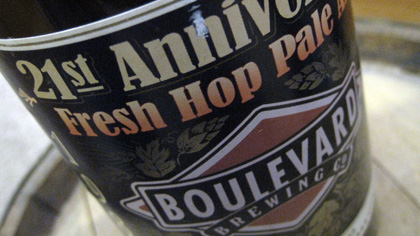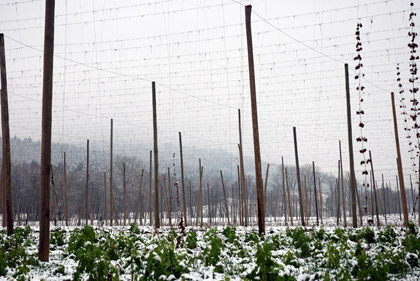“. . . on hot days there is no pleasanter place than the shady lanes of hops, with their bitter scent — an unutterably refreshing scent, like a wind blowing from oceans of cool beer.”
— George Orwell, 1931
Orwell did not exactly give hop picking a rave review. But he allowed it was not a disagreeable job in itself, and obviously took some visceral pleasure from the adventure. Crush a few fresh hop cones, give them a rub, take a deep breath and the experience lodges itself forever in our brains. We’re hardwired that way. Fresh hop ales stir those memories, not just the aroma but also the sticky, resiny texture.
That Boulevard Brewing in Kansas City would choose to brew Fresh Hop Pale Ale to celebrate its 21st anniversary — that’s today, as a matter of fact — might seem curious. After all, Kansas City it not located in the midst of hop yards. And Boulevard’s flagship Unfiltered Wheat Beer accounts for 65 percent of its sales.

However, the Pale Ale was the first beer that founder John McDonald sold and initially the flagship. There remain few experiences better than a draft Pale Ale and a burnt ends sandwich at Gates Bar-B-Q in Kansas City.
McDonald wrote the recipe, and when brewmaster Steven Pauwels joined Boulevard in 1999 he saw no reason to tinker. “I have always liked Pale Ale the way it was when I started at Boulevard and have done the best I can to keep it the same way despite brew house upgrades, increased fermenter sizes, filtration changes, bottle line changes, etcetera,” he said. “Some of the original ingredients have changed but Cascade flower hops have been a constant.”
Cascade hops provide the fresh component — 500 pounds as a dry hop* in the 125-barrel batch — because Pauwels wanted to pay tribute to the hop that “helped create the craft beer movement” as well as the original Pale.
Fresh Hop Pale is not simply Pale “grown up,” although heftier (7.2% abv and 44 bittering units compared to 5.4%/30 IBU). Different hops — for the record Cascade, Mangum, Palisade, Simcoe and Styrian Golding in the Pale; Cascade, Hallertau, Magnum, Styrian Golding and Centennial in the anniversary beer — but more importantly the 21st is built on a base of Maris Otter, the rich English pale malt.
Not as brazen as in an Americanized India Pale Ale, the hops are not shy — resiny, piney, some orange and grapefruit rind, certainly to be enjoyed fresh — but for me (your mileage may vary) the Maris Otter steals the show. Abetted and perhaps refined by bottle conditioning, it provides texture that plays perfectly with spicy hop flavors. A beer in harmony.
McDonald offers a bit of a toast at the Boulevard website, so I’ll leave the last words to him.
*****
* Yes, the “wet hops” used as “dry hops.” That’s brewing for you. Enough to make a soul think twice about writing a book about hops.

